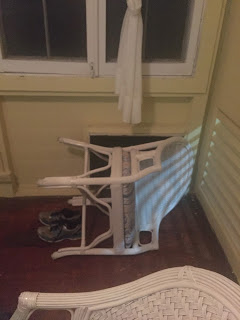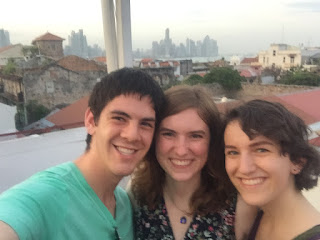View of an Azteca nest
My work this summer has focused on Azteca refuse, and the variety of impacts that it has on life in the forest. Now, you might question why I would chose to spend the summer studying ant poop. But it actually plays some very important roles in the ecosystem. The refuse is enriched in a wide variety of nutrients, which can be important for different plants. Since the nutrient-rich refuse accumulates close to the nests, it helps to drive habitat heterogeneity on the forest floor (an important factor for invertebrate diversity). It's normally difficult to study the impacts of insect waste since it is so diffuse; however, Azteca make the perfect study subject since waste will accumulate under their long-lasting nests. Azteca refuse contains lots of chemicals and pheromones, which other organisms might respond to. Azteca are very aggressive ants (I can attest that they are not happy to have interns hovering around their nests), so my mentor and I had hypothesized that other ant species would avoid their refuse.
The first part of my project examined how Azteca impact plant growth and herbivory. At the beginning of the summer, I collected Ochroma (balsa) seeds, cleaned them, and planted them. Once the plants were around a centimeter in height, we placed them in the field. I had 80 pots out- half of them under Azteca nests (where the seedlings received nutrients from the refuse and potentially protection), and the other half ten meters from the nests. Once a week I hiked out to measure and photograph all the seedlings. After six weeks, I collected and weighed them. Grand conclusion: lots of organisms like to eat Ochroma seedlings. Of the 80 I planted, only 3 survived. Despite our initial hypothesis, there was no difference in growth or survival based on proximity to Azteca nests. This is actually a super interesting result, since there was a major difference in growth when seedlings were treated with refuse in the greenhouses last year. We're trying to figure out what caused this difference (it could be that Azteca prune away the seedlings by their nests, or it could be that survival is just so low in the forest that the nutrients from the refuse make no difference.) Either way, it's good for the Azteca nest's host tree- it gets the benefit of nutrients from the refuse without facing additional competition from seedlings.
For the second part of my study, I set out Azteca refuse, Azteca nest material, and sterilized soil (as a control) in front of Atta leafcutter ants and Eciton army ants, and filmed their reactions. Azteca attack both of these species, so I had expected them to avoid the refuse and nest material. The army ants did indeed avoid them (important, since army ants attack lots of species. If Azteca keep the army ants away, many insects that Azteca don't attack will live in those trees). Leafcutter ants, on the other hand, removed the refuse and nest material, likely because they keep their foraging trails and nests clear of any waste to prevent disease. This project involved lots of videos of ants! Tripods aren't well suited for pointing a camera straight down, so I created the lovely camera array above out of two plastic dog food containers, PVC pipe, liberal amounts of duct tape, and a GoPro. Do I count as a real field scientist now? This project was my absolute favorite to work on, since it involved lots of hours wandering Barro Colorado's beautiful forests in search of leafcutter and army ants.
I've had a fantastic time with STRI this summer, and have grown as a scientist and as a person. I'm so thankful to have had the opportunity to spend months working on Barro Colorado Island, meeting scientists there, and experiencing some of Panama. I'm lucky to have been a part of the Kaspari lab, and Jane Lucas has been an incredible graduate mentor! I'm very grateful for STRI and the REU program for giving me this wonderful opportunity.
Sunrise on the island
The REU interns on Barro Colorado Island- me, Dan, Annika, and Lynn. They're amazing people!
Annika and I were super excited to see this sloth
The beautiful island Taboga, where we spent a day off
Spider monkey!
Barro Colorado Island has really incredible forests




































































